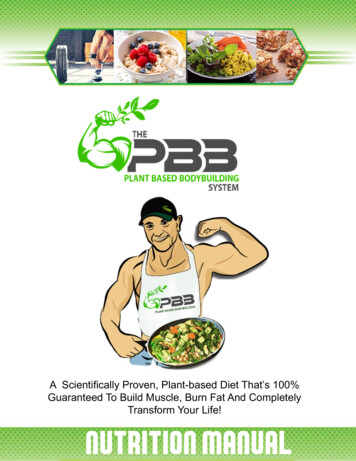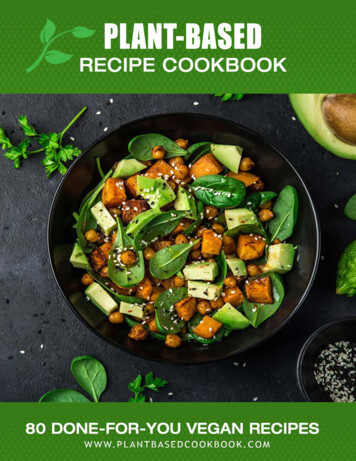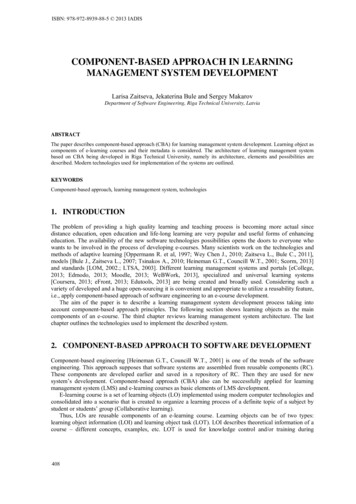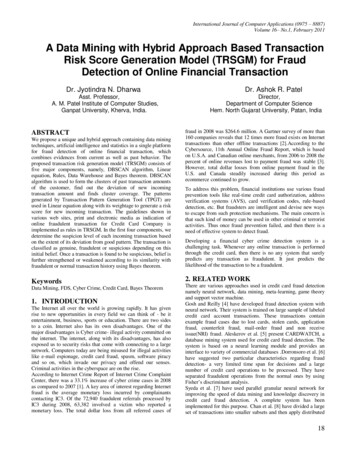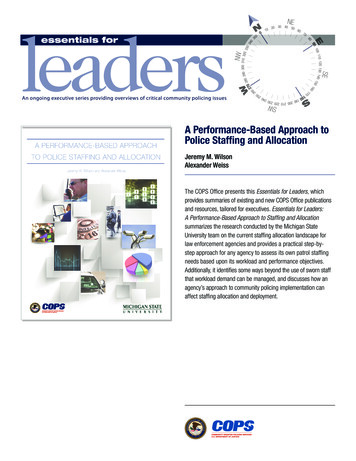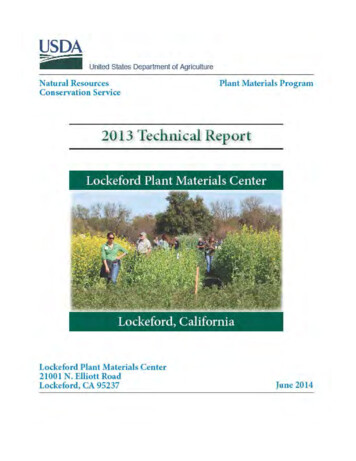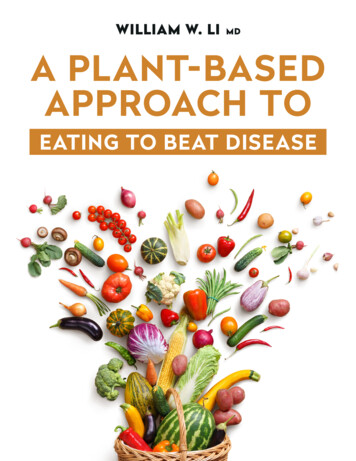
Transcription
A PLANT-BASEDAPPROACH TOEATING TO BEAT DISEASE
PLANT-BASED DIETSWhat if there was a way we could kill cancer stem cells, support our immune system, protect our DNA,and stimulate the development of blood vessels in the body? Well, I have some exciting news for you —we can. The prescription is simple: eat delicious food. My forthcoming book, Eat to Beat Disease: TheNew Science of How the Body Can Heal Itself, highlights the science that proves this to be true. Betteryet, the foods we look at are also proof positive that by choosing to eat a plant-based diet, you’ve alreadymade an incredibly impactful choice for your health.Just take a look at some of the science that shows how plant-based eating supports your health: Lengthens your telomeres: Telomeres are the end strands of our DNA that protect themfrom damage. Think of them like the little cap on the end of your shoelace — they preventthe rest of your DNA from falling apart! A recent study reports that vegetable-rich diets areassociated with longer telomere length in women. Longer telomeres healthier DNA!Allows our microbiome to live long and prosper: Plant-based foods arenature’s powerhouses for delivering natural dietary fibers to your body. Dietaryfiber is what feeds the organisms that live within your microbiome, so the more ofthose you eat, the healthier and stronger your microbiome becomes. Why does thatmatter? Well, the microbiome is linked to your body’s other health defense systems,so maintaining a healthy microbiome is vital to essential processes like angiogenesis(blood vessel development), stem cell function, and DNA protection!Guards your DNA: Plant-based diets are also rich in bioactives (compounds present in foodthat have an effect on the organism consuming it) that benefit the body. For example, theantioxidants found in oranges, like vitamin C, naringenin, and hesperidin, have been shownto improve the properties of blood to protect DNA. The combined antioxidant benefitsgained from consuming whole foods are more powerful than swallowing a supplement,adding evidence that eating a healthy diet is better than using vitamins as a shortcut.Meaningfully treats immune disease: Another benefit? The compounds available inplant-based diets also calm your immune system and help with major immune disorders,like MS. A recent study even showed plant-based eating can help improve MS symptoms.And this all comes just from continuing to eat the foods that are already on your plate! Wonderinghow you can magnify these impacts even further? Then I suggest learning about the 5x5x5 framework,2
which I lay out in Eat to Beat Disease. This model is intended to help you make food choicesthat positively affect the body’s five defense systems (angiogenesis, regeneration, DNA protection,microbiome, and immunity) each and every day. Optimizing your plant-based diet to improve eachsystem using this model is the next step to leading a healthier, happier life.Want to get started? Let’s go through a few examples of foods with built-in health effects, look atkitchen tips that could change your life, and practice revolutionizing your health with a few new recipes.3
5 FOODS WITH SURPRISINGHEALTH BENEFITSReady to restock your fridge and take your diet to the next level? Eat to Beat Disease will have thecomplete list of 5x5x5 foods (there are over 200 foods scientifically proven to optimize one or moredefense systems!), but below are five of my favorites, and information about the surprising health benefitsthey offer. Add these to your shopping list today!Purple Potatoes: Food Fit for RoyaltyOriginating from Peru, the purple potato was prized by the Incas forits nutritive benefits. Little did the Incas know, it was because thesepotatoes contain the bioactive anthocyanin, a blue-purple pigmentthat also gives dark berries their hue. It’s this natural dye that packsa healthy punch. Researchers have found that purple potatoescan have health effects that range from wiping out colon cancercells to killing cancer stem cells!Researchers at Penn State University found in a laboratory testthat, compared to an anti-inflammatory drug called Sulindac,purple potatoes had a comparable efficacy of starving coloncancer stem cells of key survival factors they needed to grow,effectively killing them. Best of all, these bioactives seems toremain stable under many different conditions, so you can cookand enjoy the potatoes any way you like!Kiwi: A Darling for DNAWe should first talk about the kiwi by correcting our nomenclature. The fruitwe call kiwi has a proper name: kiwifruit. It’s actually a large berry that originated in China, where itwas once collected from the wild for medicinal purposes.With that settled, we should thank the kiwifruit for the positive improvements it brings to ourmicrobiome (maintaining the integrity of our lining to prevent “leaky gut”), glucose metabolism,and lipid metabolism. Kiwifruit also contains high levels of vitamin C, chlorogenic acid (just like4
blueberries!), and quinic acid, which all have antioxidant effects.Perhaps most interestingly, researchers at the Rowett Research Institute in Scotland examinedkiwifruit’s ability to reduce DNA damage. They recruited 14 healthy volunteers and gavethem one, two, or three kiwifruits to eat each day. The participants ate a different dose offruit during each of three periods of time, and their blood was drawn for a Comet assay atthe beginning and end of each period. The results showed that eating kiwi, regardless ofthe amount, could reduce DNA damage by approximately 60%. When the researcherslooked further at the DNA, they found that eating three fruits per day actuallyincreased DNA repair activity by 66%. So, eating kiwifruit not only aids the blood inneutralizing DNA-damaging free radicals, but it also helps rejuvenate DNA that hasalready been damaged!Blueberries: An Athlete’s Best Friend?More than just a smoothie favorite, blueberries are worthy of a dedicated daily dose.Their blue hue comes from the bioactive delphinidin, an antiangiogenic compound. Otherbioactives, like resveratrol and cholorgenic acid, can activate cardiac stem cells and regenerateheart tissue under stress, protect stem cells, or have anti-inflammatory, antiangiogenic, and bloodpressure lowering effects.If you’re an athelete, then pay blueberries extra attention. A consortium of academic researcherscollaborated on a study aimed at defining the impact of blueberries on the body after intense exercise.At the end of six weeks of eating blueberries, study participants did a two-and-a-half hour treadmill runand blood was drawn to see what happened to their immune cells, and the effect of eating blueberries.The blood samples were analyzed for different immune cells, including T-cells, B-cells, and naturalkiller (NK) cells.The results were eye-opening. Blueberry eaters had almost double the number of NK cells beforeexercise compared to those who did not eat blueberries. More surprisingly, NK cells remained elevatedin these individuals for at least one hour after exercise ceased, which is the exact inverse of what isnormally observed, as NK cells tend to rapidly decline after intense exercise!The ability of blueberries to increase NK cell numbers, even in circumstanceswhere they would ordinarily decline, is significant. NK cells are critical to immuneresponses that eliminate virus-infected cells or tumor cells, and they can helpthe immune system develop learned responses to foreign invaders.5
Who’s ready for a cancer-fighting, DNA-repairing blueberry and kiwi fruit salad?!Tea: Pour an Extra CupTea, the second most popular beverage in the world after drinking water, has been brewed for morethan 4,000 years. Tea leaves contain more than 2,000 bioactive compounds, like catechins (EGCG),gallic acid, and theaflavins. Tea extracts have really potent angiogenesis inhibitory effects.In addition to their antioxidant, anti-inflammatory, and antiangiogenic properties, the health-promotingpolyphenols in tea enhance the microbiome. Overall, drinking any tea increases good bacteria, decreasesbad bacteria, and helps the microbiome produce more of the beneficial health-promoting short chainfatty acid metabolites.Different varietals of teas exhibit different potencies, but here’s what you can expect from my favoritetypes:Green TeaOf course, most people commonly think of green tea as the healthiest tea, and we can thank thepresence of polyphenols like EGCG for that. EGCG reduces harmful angiogenesis and cancer growth,lowers blood pressure, improves blood lipids, restores homeostasis of immune cells, and has antiinflammatory properties. Drinking 2-3 cups of green tea daily reduces the risk of colon cancer by 40%.Specific to cancer, green tea meaningfully impacts cancer stem cells, which are responsible for initiatingthe growth of many cancers, as well as igniting recurrence after treatment. One recent discovery showedthat green tea (because of the presence of EGCG) can kill cancer stem cells by starving them of the vitalblood supply they need to metastasize. This effect may help explain one of the many protective effects oftea against colon and other cancers.Black TeaAccording to popular lore, black tea should be devoid of health benefits becauseit is fermented and has fewer polyphenols than green tea. However, black tea canmobilize stem cells, promoting regeneration.Chamomile TeaChamomile tea is an herbal tea made with the dried petals of thechamomile flower. Chamomile contains bioactives like apigenin,caffeic acid, and chlorogenic acid, which all have antiangiogenic6
activity. Researchers at the University of Minho in Braga, Portugal, found that chamomile tea couldinhibit angiogenesis by preventing signals that activate blood vessel cells from being sent.Pomegranate: Get to Know AkkermansiaWhether you think of yourself as a certified health nut, or just enjoy an occasional scroll through thescience section of your favorite news website, you’ve likely already seen or heard about the reams ofresearch into the microbiome. There’s good reason for that — it’s one of our body’s five key defensesystems, and it wields wide-ranging influence over our health.The microbiome is made up of trillions of bacteria and I’m a big fan of one in particular: Akkermansiamuciniphila. (I know, it’s a mouthful!) It only makes up only 3% of all the bacteria in the gutmicrobiome, but this small population carries a big stick! Akkermansia can help control the immunesystem, improve blood glucose metabolism in the body, decrease gut inflammation, and combat obesity.Its impact on the immune system is especially startling. Out of 37 trillion bacteria in the microbiome,the presence of Akkermansia predicts the best response to a cancer immunotherapy. If patients havethe bacteria, they are more likely to respond and fight their own cancer. If they lack the bacteria, theirimmune system may not respond, and the treatment fails. Checkpoint inhibitors, one of the mostcutting-edge forms of cancer treatment, which use the body’s own defense systemsto fight cancer, are proving to work most effectively in patients where a richpopulation of Akkermansia is present in their gut.Unfortunately, if you’re rushing to the health food store or Amazon to buyAkkermansia, you’re out of luck. It is not effective as a probiotic. But you can eatcertain fruit and drink their juices to change the gut’s environment to become onethat will stimulate the growth of Akkermansia.The best option? Pomegranate juice, which is high in ellagitannins, hasbeen shown to encourage growth of Akkermansia!7
5 KITCHEN TIPSEating to beat disease is about more than just food choices, it’s lifestyle ones too! When it comes to your kitchen,that means being smart about how you eat the foods you love. Should you reheat your leftovers in the microwaveor the toaster? Drink water from a plastic bottle or a glass one? Read on to find out!Avoid MicrowavingIf leftovers are to be reheated, use the oven, stove, or toaster oven to heat gradually, instead of themicrowave. Especially avoid microwaving starchy foods, since the high heat will change starches intoa harmful polymer that can amass inside your body and cause damage to your organs. Extra credit: Packthat lunch in a glass or metal, not plastic, container!Make Smart Extra Virgin Olive Oil (EVOO) ChoicesStock up on cold-pressed olive oils made from one of the following monovarietals: koroneiki (Greece),picual (Spain), moraiolo (Italy) as they have the highest levels of polyphenols. Store EVOO in a darktinted jar or bottle to protect it from light, which can make the oil become rancid, as well as degradethe health-promoting bioactives. EVOO can keep for up to 2 years from the date of bottling, if kept in acool, dark area.When using, do not heat olive oil (or any other oil) to its smoking point, which can generate toxicfumes as well as convert the oil into harmful trans-fats. If you are sautéing or stir-frying, use only a castiron, stainless steel, or nonstick ceramic pan.Use All Of The VegetableThe discarded portions of our veggies can be the healthiest! For broccoli, don’t just cook the florets,prepare the stems, too. Same with mushrooms. Although we traditionally cook with the tops and throwaway the stems, use them! The stems of both broccoli and mushrooms contain high levels of bioactivesthat support health defenses. Similarly, with carrots, not only should you buy whole fresh carrots,including their green tops, but you should also cook the greens. And when you cook with tomatoes,know that the skin contains high amounts of lycopene. Eat tomato skin!8
Avoid Bottled WaterMany people keep bottled water in their pantry for easy hydration, but I recommend you avoidregularly consuming water from plastic bottles. Studies have shown that even without BPA plastic, theplastic particles called “microplastic” will seep into the water you drink. One study found as many as2,400 pieces of microplastic in just 8 fluid ounces of bottled water!A hack for better water? Keep a glass pitcher of chilled water in the refrigerator, and add bioactives toit by dropping in sliced citrus, berries (blueberries!), celery, or cucumber to create refreshing, lightlyflavored water. Transport with your own stainless steel, glass or other reusable water bottle.Add Black PepperBlack pepper, like a few other spices mentioned in Eat to Beat Disease, won’t just bring out the flavorin your food, it will also unlock defense system-optimizing capabilities inside your body. Piperine, thebioactive in pepper, leads to better absorption of other food bioactives, like curcumin from turmeric.Use whole peppercorns and grind, rather than relying on pre-ground pepper. It will give you a freshertaste — and promotes better absorption.9
5 PLANT-BASED RECIPESBROCCOLI RABEWITH SPAGHETTIBroccoli rabe contains glucosinolates that break down during digestioninto bioactive metabolites with health benefits. Regular dietary intakeof cruciferous vegetables lowers the risk for developing several cancers,including breast, prostate, lung, and Non-Hodgkin’s lymphoma.10
BROCCOLI RABEWITH SPAGHETTIINGREDIENTSDIRECTIONSServes 4 salt 65 ml (1/3 cup) extra virgin olive oil 6 cloves of garlic, thinly sliced Heat a few inches of water to rolling boil, add saltto the water and cook broccoli rabe 3 minutes.1 large bunch (750 g / 1 1/2 lbs)broccoli rabe, stem ends trimmedPlace in ice water bath to cool, drain, dry, and cutinto 2 inch pieces.Heat a large pot of water to boil for pasta.15 g (1 Tbsp) Calabrian chili paste or 2small red chili peppers, finely choppedHeat a large skillet over medium heat with extravirgin olive oil, 5 turns of the pan. 125 ml (1/2 cup) dry vermouthAdd garlic and chili paste, stir another minute. 500 g (1 lb) spaghetti or farro spaghettiAdd dry vermouth and add broccoli rabe.Taste to adjust salt and chili, reduce heat tosimmer.Meanwhile, salt the boiling water and cookspaghetti 1 minute less than package directions.Add 1-2 ladlefuls of starchy water to broccoli rabe;drain pasta and toss to combine.11
POMEGRANATE, ORANGE,AND ENDIVE SALADThe seeds of pomegranate contain high levels of polyphenols known asellagitannins, which have been shown to inhibit the growth of prostatecancer. Consuming both the fruit and the seed (together called the aril)may have more benefit than drinking juice of the fruit alone.12
POMEGRANATE, ORANGE,AND ENDIVE SALADINGREDIENTSDIRECTIONSServes 4Separate Belgian endive into individual leaves. 2 small heads Belgian endive leaves 50 g (2/3 cup) fennel 75 g (1/2 cup) pomegranate arils (seeds) 2 navel or blood oranges 15 g (3/4 cup) arugulaPick tender fronds from the head of fennel. fennel frondsPlace all ingredients in a bowl. 20 ml (1 ½ Tbsp) extra virgin olive oil 5 ml (1 tsp) orange juice 5 ml (1 tsp) red wine vinegar salt Aleppo pepperShave fennel thinly using a sharp knife ormandoline.Peel and cut oranges into segments.Mix olive oil, orange juice, vinegar, salt, andpepper. Pour into bowl and toss gently.Serve promptly.13
RAW PORCINI STEM SALADAND ROASTED CAPS WITHCALAMINT SALSA VERDEMushrooms contain a bioactive called beta-glucan that promotes theimmune system through the gut microbiota. Beta-glucan also suppressesthe growth of tumor blood vessels and inhibits cancer growth. Up to 13%of the fiber content of porcini mushrooms is made up of beta-glucan.14
RAW PORCINI STEM SALADAND ROASTED CAPS WITHCALAMINT SALSA VERDEINGREDIENTSDIRECTIONSServes 4 Place the roughly chopped herbs in a mortar andgrind them into a paste. Mix in the garlic and addenough olive oil to cover. Just before serving, mixthe shallots with the herb paste and season withsalt and pepper.8-10 small tomatoes, on the vine if possible15 g (1 Tbsp) calamint* leavescoarsely chopped30 g (2 Tbsp) fresh basil leaves,coarsely chopped (about 24 leaves)Season the vine tomatoes with olive oil, salt, andpepper. Roast in a moderate oven (325 F/162 C)until the skins blister and the flesh is slightlycaramelized and fragrant, about 20-30 minutes.15 g (1 Tbsp) fresh mint, coarselychopped (about 12-15 leaves) 1 shallot, minced 1 lemon, juiced Macerate the minced shallot in enough lemonjuice to cover. Set aside.360 g (12 oz) fresh porcini,caps and stems separatedWhile the tomatoes are in the oven, cut theporcini caps into thick strips, season to taste withsalt and pepper, and pan fry them in olive oil witha crushed clove of garlic until golden brown andtender. Arrange them on a warm shallow servingbowl with the vine tomatoes and all their renderedjuices.¼ clove garlic, crushed to a pastewith the side of the knife 1 clove garlic, crushed extra virgin olive oil, as neededVery thinly slice the raw porcini stems with asharp knife or mandoline; dress with olive oil,lemon juice, and some of the salsa verde. Arrangethe marinated stems on top of the tomatoes androasted porcini tops. Serve the extra salsa verde onthe side.NOTE*Calamint is also known as nepitella or wildTuscan mint. If unavailable, you can substituteoregano or marjoram.15
ROASTED TOMATOESWITH ORECCHIETTEStudies show that men who eat more tomatoes have lowered risk ofprostate cancer. This cancer-fighting activity may be attributed totomato’s lycopene content, which is highest in the San Marzano tomato.There is a high amount of lycopene in tomato skin so consuming wholetomatoes may have more health benefits than eating peeled tomatoes.16
ROASTED TOMATOESWITH ORECCHIETTEINGREDIENTSDIRECTIONSServes 4 to 6 For San Marzano tomatoes, cut in half lengthwise,remove excess seeds and stem. Chop into bitesize pieces. If using cherry tomatoes, cut in halflengthwise.50 ml (¼ cup) extra virgin olive oil,plus additional to drizzle on top 2 cloves of garlic finely chopped small handful flat leaf parsley, chopped salt 50 g (½ cup) breadcrumbs 10-15 basil leaves, cut into thin strips optional: crushed red pepper (peperoncino) Preheat oven to 200 C / 400 F.500 g (1 lb) ripe San Marzanotomatoes, or cherry tomatoesAdd chopped tomatoes to an oven-safe casserolepan. Add chopped garlic, parsley, olive oil, salt,and red pepper if using. Stir to combine allingredients.Sprinkle breadcrumbs over the top of the tomatomixture; drizzle a little olive oil over the top.Roast in oven for about 20-25 minutes coveredwith foil until tomatoes are bubbly. Remove foiland cook 5-10 minutes longer until topping turnsgolden brown.500 g (1 lb) orecchiette pasta, orother pasta of your choiceMeanwhile, bring large pot of salted water to aboil. Cook orecchiette pasta until al dente. Drainpasta, add to roasted tomato mixture; stir well tocombine.Sprinkle basil over the top. Additional olive oilmay be added over the top when serving.17
WALNUT ANDARUGULA PESTOWalnuts are a rich source of omega-3 fatty acids, lignin, quercetin, ellagicacid, and other bioactive molecules that boost brain health, promote ahealthy microbiome, and improve outcomes in prostate cancer.18
WALNUT ANDARUGULA PESTOINGREDIENTSDIRECTIONSServes 4 300 g (3 cups) walnuts, toasted 100 g (2 cups) arugula 60 g (4 Tbsp) red miso 12 cloves garlic, peeled and grated 15 ml (1 Tbsp) sherry vinegar 10 ml (2 tsp) lemon juice 50 ml (¼ cup) garlic oil 35ml (2 ½ Tbsp) extra virgin olive oil 25 ml (4 tsp) walnut oil salt black pepper, freshly cracked from a millIn a food processor pulse the walnuts until they arecoarsely chopped.Add arugula, red miso, garlic, lemon juice, andvinegar.With food processor running slowly add the oilsuntil a paste forms.Serve with pasta or sautéed or grilled vegetables.19
EAT TO BEAT DISEASEForget everything you think you know about your body and food and discover the new science of how the bodyheals itself. Learn how to identify the strategies and the dosages for using food to transform your resilience andhealth in Eat to Beat Disease. We have radically underestimated our body’s power to transform and restore ourhealth. Pioneering physician scientist, Dr. William Li, empowers readers by showing them the evidence beh indover 200 health-boosting foods that can starve cancer, reduce your risk of dementia, and beat dozens ofavoidable diseases. Eat to Beat Disease isn’t about what foods to avoid, but rather is a life-changing guideto the hundreds of healing foods to add to your meals that support the body’s defense lliamLiTwitter.com/DrWilliamLiDrWilliamLi.com20
Allows our microbiome to live long and prosper: Plant-based foods are nature’s powerhouses for delivering natural dietary fibers to your body. Dietary fiber is what feeds the organisms that live within your microbiome, so the more of those you eat, the healthier an

